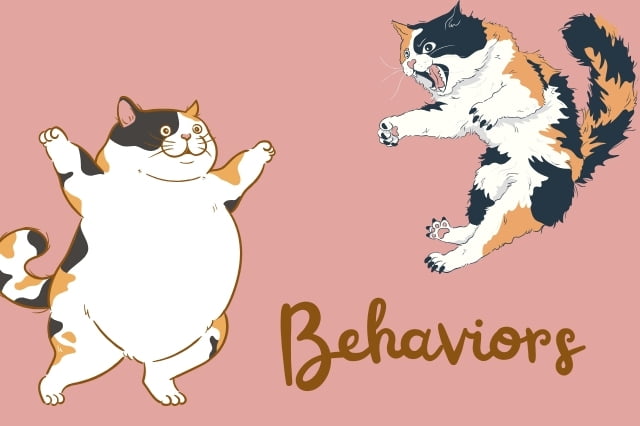Calico cats are known for their striking tri-colored coats, but their appeal goes beyond their beautiful fur. These cats possess unique behavioral and personality traits that have fascinated cat owners and researchers alike. In this article, we will explore the common behaviors and traits of calico cats. We will also clear up myths and support ideas with studies and stories from cat owners.
Table of Contents
Calico Cat Characteristics
Calico Cat Behavior

Calico cats show many behaviors similar to those of other domestic cats. However, there are some behaviors that owners often associate with calicos:
1. Playfulness
Calico cats are often described as playful and energetic fun cats. They enjoy interactive play, such as chasing toys or engaging in games of hide-and-seek with their owners. This playfulness can persist well into adulthood, making them delightful companions.
2. Curiosity
Like many cats, calicos are inherently curious. They love to explore their surroundings, often finding cozy spots or high perches to survey their territory. This curiosity can sometimes lead to mischief, such as knocking items off shelves or investigating off-limit areas.
3. Affectionate Nature
Many calico owners report that their cats are particularly affectionate. These cats often seek out human interaction, enjoying petting and cuddling. They may follow their owners from room to room, wanting to be involved in daily activities.
Calico Cat Personality Traits

While behaviors are actions that cats exhibit, personality traits are more about the underlying temperament and characteristics. Calico cats are known for several distinctive personality traits:
1. Independence
Calico can be quite independent. They appreciate their personal space and can entertain themselves for hours. This independence doesn’t mean they are aloof; rather, they balance their need for solitude with moments of social interaction.
2. Feisty and Bold
One of the most commonly noted traits of calico cats is their feistiness. They are often bold and assertive, displaying a strong-willed nature. This trait has even led to a term in the cat community known as “calico attitude” or “cattitude.”
3. Intelligence
Calicos are known for their intelligence. They can be quick learners, often figuring out how to open doors or solve puzzles designed for feline entertainment. This intelligence makes it easy for them to train in some respects, but it also means they can become easily bored if they are not mentally stimulated.
The Genetics Behind Their Unique Traits
It’s essential to understand the genetics. The calico coloration is linked to the X chromosome.
Since females have two X chromosomes (XX), they can carry two different color genes, leading to the characteristic tri-color coat. Males, having one X and one Y chromosome (XY), rarely exhibit this pattern. The rare male calico is typically sterile due to genetic anomalies.
Debunking Myths and Confirming Theories
There are several myths and theories about calico cats that circulate among cat enthusiasts. Let’s take a closer look at some of these:
- Myth: All calicos are Female.
While it’s true that the vast majority of them are female due to their genetic makeup, male calicos do exist. They are rare and usually have a genetic anomaly such as Klinefelter syndrome, where they have an extra X chromosome (XXY).
- Theory: Calicos Have Unique Personalities.
Many believe that they have unique personalities compared to other cats. Studies have shown that calicos, along with tortoiseshell cats, can exhibit more aggressive behavior towards humans than cats of other colors. This supports the idea of “calico attitude,” suggesting this theory might have some truth.
- Myth: Calicos Bring Good Luck.
In some cultures, calico cats are considered good luck charms. For instance, in Japanese folklore, they are believed to bring good fortune to their owners. While there’s no scientific basis for this belief, it’s a charming aspect of calico lore that many owners enjoy embracing.
Owner Anecdotes: Real-Life Stories
Owner anecdotes can provide additional insights into the behavior and personality traits:
Luna’s Story
Luna, a calico owned by a family in Texas, is known for her adventurous spirit. Her owners often find her exploring the neighborhood, making new feline friends, and bringing home “gifts” in the form of leaves and twigs. Luna’s independence and curiosity are typical of many calico cats.
Molly’s Tale
Molly, a calico from New York, is the epitome of a lap cat. She loves to curl up on her owner’s lap during movie nights. Molly’s affectionate nature highlights the loving side of calico that many owners cherish.
Oliver’s Adventure
Oliver, a rare male calico, lives in California. Despite his unusual genetic makeup, Oliver is a playful and intelligent cat. His owner, Jenna, shares stories of his clever tricks and puzzle-solving abilities, showcasing the intelligence often seen in calicos.
Conclusion
Calico are more than just their beautiful tri-colored coats. They possess a range of behaviors and personality traits that make them unique and endearing companions. While they can be independent and feisty, their playful, curious, and affectionate nature makes them beloved by many. Whether you believe in the myths or appreciate the scientific theories, one thing is clear: calico brings joy and charm to the lives of those who welcome them into their homes.
Frequently Asked Questions
1. Are calico always female?
Almost all calico cats are female due to the genetic mechanism behind their coat coloration, which is linked to the X chromosome. Male calicos are rare and typically have an extra X chromosome (XXY), a condition known as Klinefelter syndrome.
2. Do calico have a unique personality compared to other cats?
Yes, calico cats are often described as having a unique personality. They are known for their feistiness, independence, and intelligence. This distinctive personality trait has even led to the term “calico attitude.”
3. Are calico more aggressive than other cats?
Some studies suggest that calico cats, along with tortoiseshell cats, may exhibit more aggressive behaviors towards humans compared to cats of other colors. However, this can vary widely among individual cats.
4. What breeds can have calico cats?
The color of the calico pattern can appear in various cat breeds, including the American Shorthair, Persian, Maine Coon, and more. The pattern is not specific to any breed but rather a genetic trait.
5. Are calico cats friendly?
Many calico cats are very affectionate and enjoy human interaction. They often seek out attention from their owners, enjoying petting and cuddling. However, their friendliness can vary depending on the individual cat’s personality.
6. Do calico cats bring good luck?
In some cultures, calico cats are considered good luck charms. For example, in Japanese folklore, they are believed to bring good fortune to their owners. While this belief has no scientific basis, it is a charming part of calico lore.
7. Why are male calico cats sterile?
Male calico cats are usually sterile because they have an extra X chromosome, resulting in an XXY genetic makeup. This condition, known as Klinefelter syndrome, often leads to infertility in these rare male calicos.
8. How can I tell if my cat is a calico?
A calico cat will have a predominantly white coat with large patches of two other colors, typically orange and black. The distinctive tri-colored pattern white, black, and orange
is the hallmark of a calico.
9. Are calico cats good with children and other pets?
Many calico cats are great with children and other pets, especially if they are well-socialized from a young age. Their playful and affectionate nature can make them wonderful companions in a family setting.
10. How can I care for a calico cat’s unique needs?
Caring for a calico cat is similar to caring for any other domestic cat. Ensure they have a balanced diet, regular veterinary check-ups, and plenty of mental and physical stimulation. Given their intelligence and curiosity, interactive toys and activities can help keep them engaged and happy.



